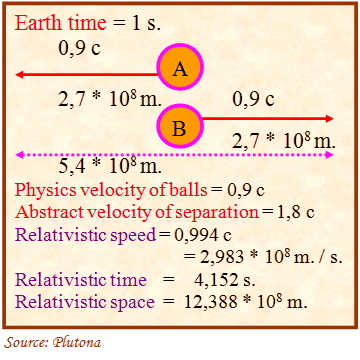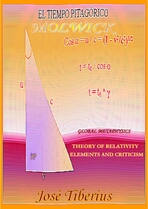2.c.1.b) Uniform rectilinear motion (URM) and relativity
The first criticism of Einstein’s Theory of Special Relativity (SR) on the topic of uniform rectilinear motion (URM) is that we do not like the terminology of inertial and non-inertial reference frames for various reasons.
I am not comfortable with so many technical connotations of a concept; of course, this may be my own limitations. I will now present a few ideas I hope will explain why problems start with terminology of inertial and non-inertial reference frames, and why they worsen when you try to look at it more in-depth.
Physical system and reference system
A system of reference is an abstract concept that allows us to identify points in space from an arbitrary origin.
A physical system is a set of things and energies. They should not be confused, because, in Relativity, one talks stereotypically about reference systems where all of them are at proper rest by definition, and they may contain elements that are at rest, have uniform motion or acceleration.
The term “inertial”
Neither Newton Classical Mechanics nor Modern Physics explain the cause and mechanisms of inertia. The model proposed by Global Physics does so in the book Physics and Global Dynamics.
The term inertial makes us think of the inertia of objects to continue in their trajectory, whether it is physical, historical or from any other circumstance. Nevertheless, an accelerated system also implies inertia, even if it is not the only cause of its movement.
Maybe non-inertial systems should be supra-inertial systems!
Therefore, it seems that a concept used to limit the technical scope of Special Relativity is contrary to its ordinary meaning in Physics. What’s more, sometimes it incorporates the notion of the principle of equivalence from General Relativity.
One system or a relation between reference systems
When one talks of inertial or non-inertial systems, one should be talking about the relation between the two systems because all systems considered individually are always at rest by the pure convention of frames of reference. Except if –going back to the previous part– we are talking in RG about a system in a space with gravity –or with geometric effects.
Inertial reference systems
In Classical Mechanics, when changing between inertial frames of reference –in uniform relative motion– there are the so-called Galileo invariants.
In SR, this definition is the same, but the Lorentz transformations affect space, time, and the concept of relativistic mass and proper mass or mass at rest appear.
In GR, due to the Principle of Equivalence, the concept of inertial reference frame changes and the mass is invariant.
Inertial systems and accelerated systems
In any case, one talks about inertial and non-inertial systems but does not use the terms accelerated or non-accelerated systems, because there are systems that are not in motion, but considered as accelerated because of the principle of equivalence between gravity and acceleration from Einstein’s General Relativity.
Unsuccessful attempts of conceptual simplification
When they mention that in inertial reference frames mass does not change with velocity, it may seem that inertial systems correspond to Newton classical mechanics, and non-inertial systems to SR. Unfortunately, it has nothing to do with it. SR deals with inertial reference systems and GR with non-inertial ones, though the latter could have been inertial in the SR sense.
Fictitious forces
One has to admit that talking about the appearance of fictitious forces in non-inertial reference systems gives the topic a melodramatic touch. Some neurons even start to think about when the nightmare they are in will end, and what they have done to deserve this.
Reference systems and observers
Another reason why we do not like the terminology used is that observers are also inertial or non-inertial. It seems to be an improper personalization of scientific texts. To see the effect that all this kind of expressions has on our brain, we could ask ourselves how a non-inertial observer could see an immobile object in an inertial frame of reference. Simple!
Continuing with the simplicity of the model, the concepts of inertial and non-inertial observers give the impression that the physical reality depends on them. Ah, but that is what it is all about! We always would have thought that it is about altering the point of view, or the measurement system, or our glasses, or whatever but that the physical reality, if it does indeed exist, is only one. Alternatively, two at most!
The theory of the ignorant observer of section Relativistic physics and mathematics of this book also deals about this dependence.
That is, within the terminology of initial concepts, there are multiple ideas and some of them quite advanced. It is may be useful for specialists –although one would not think so– but, for those who try to understand relativity without dedicating fifty years of their lives to the task, it is quite a setback. Instead of science that simplifies the physical reality, it reminds us all the geographical abundance of a linguistic terminology.
I am starting to understand why my father, when I was little, talking about things with other grown-ups, would sometimes use a Spanish expression which literally meant, “One must not confuse speed with bacon,” meaning just that one must be careful not to mix up two utterly different concepts. He repeated this, not frequently, but often enough that one could tell he thought there was enough conceptual flexibility. I cannot even imagine what he would have said if he had studied Modern Physics!
Non-distinction between physical or real velocity and relative, mental or abstract velocity
Let us see a simple example, which will enlighten us when it comes to the idea of maximum velocity in Theory of Relativity.
In order to make this more intuitive, we are going to suppose that the balls shown in the figure are small particles that shot out in uniform rectilinear motion in the opposite direction to each other and with a speed of 0.9 c.
BALLS OF LIGHT 
When we measure their relative velocity, we will obtain 1.8 c, as after one second they will be at a distance of 5.4 * 108 meters due to their uniform linear motion. Because of the axiom, (anything except experimental proof) dogma, or whatever you want to call it, that c is the maximum velocity; this result cannot be correct. Consequently, when we apply the “adequate and correct” formulae we obtain the result that this velocity is 0.994 c, the time is 4.152 seconds instead of one, and that the space between them is 12.388 * 108 meters.
We could say it is something like the asymptotic-Pythagorean lowest common multiple!
This notion is one of the critical ideas against Theory of Relativity, which is why we use an unusually showy title for the figure below. A maximum limit is set, but not to the speed of light or physical speed, but to a speed that only exists in mind, as the speed of separation is a concept.
It is fair to say that there is a division of opinion in the physicists consulted concerning this existence of a speed of 2c or close to it. It is almost as if relativity also affected technical opinions; it reminds us of the King’s Indian defense of classic castling or survival by Darwinian adaptation.
Consequently, the need to make time relative is automatic, and everything that comes after. By pure design of the model! One applies the asymptotic transformation of relativistic velocity so that it can never be higher than c.
There must be compelling reasons behind why the scientific community has accepted this way of proceeding for a century.
It happens to all of us when it comes to coincidences; when two bizarre things coincide, we will assume that the only common factor we can find must be the one to explain it. In the case of Theory of Relativity, quite a few weirder things coincided, so it makes some sense they accepted it in its time.
Carrying on with the example, these assumptions of higher abstract velocities are entirely verifiable in an infinite number of cases. Suffice it to mention all the antipodal photons of all luminous stars and bulbs.
Therefore, the proposed dilation of time and shrinkage of space is completely artificial and imaginary.
We have another doubt; if maximum and constant speed of light is *c*, where is the need to apply an asymptotic transformation to prevent it from changing? We are afraid that all cases in which there are Lorentz transformations they are in some way similar to this example.
Finally, one could cite the philosophical argument of when we make one ball the spatial reference origin; we cannot know if it is at physical rest or not, therefore, which ball is moving? Consequently, we apply the conventional formulae where c is the maximum velocity.
The reasoning does not add anything new. The ignorance of the balls when it comes to which one of them is in motion –whether it is in uniform rectilinear or geodesic motion–, does not negate the fact that reality exists, with specific physical laws that it must adhere to, and if possible, that they have minimal common sense.
The book Global Mechanics of Global Physic discusses the Global Aether or reticular structure of matter –supporting medium of the gravity field and, indirectly, of electromagnetic energy because the gravity field is the LUM Aether (Luminiferous, universal, and mobile)– and the physical meaning of the mass-energy equivalence.
The implications of gravity on the concept of movement, force, and the reticular mechanism of kinetic energy appear in depth in the book Physics and Global Dynamics.
